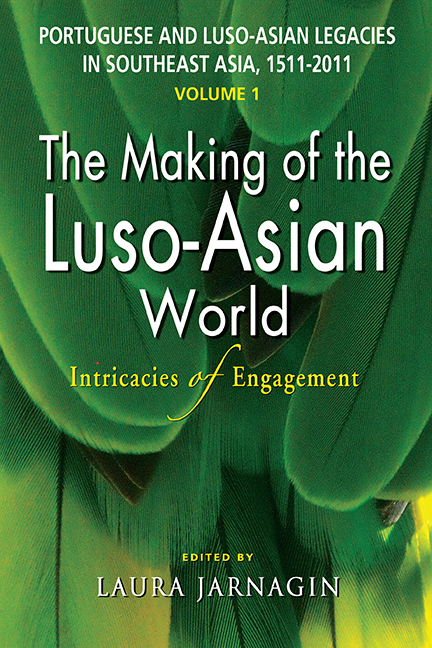 Portuguese and Luso-Asian Legacies in Southeast Asia, 1511–2011, vol. 1
Portuguese and Luso-Asian Legacies in Southeast Asia, 1511–2011, vol. 1 Book contents
- Frontmatter
- Contents
- List of Charts, Figures and Tables
- A Tribute to Glenn Ames
- Preface
- List of Contributors
- Glossary
- Introduction: Towards Clarity through Complexity
- Part One Adaptations and Transitions in the South and Southeast Asian Theatres, Sixteenth through Eighteenth Centuries
- Part Two Dispersion, Mobility and Demography from the Sixteenth into the Twenty-first Centuries
- 6 The Luso-Asians and Other Eurasians: Their Domestic and Diasporic Identities
- 7 The Population of the Portuguese Estado da Índia, 1750–1820: Sources and Demographic Trends
- 8 Flying with the Papagaio Verde (Green Parrot): An Indo-Portuguese Folkloric Motif in South and Southeast Asia
- Part Three Mixed Legacies: The Portuguese and Luso-Asians in the Twentieth and Twenty-first Centuries
- Bibliography
- Index
7 - The Population of the Portuguese Estado da Índia, 1750–1820: Sources and Demographic Trends
from Part Two - Dispersion, Mobility and Demography from the Sixteenth into the Twenty-first Centuries
Published online by Cambridge University Press: 21 October 2015
- Frontmatter
- Contents
- List of Charts, Figures and Tables
- A Tribute to Glenn Ames
- Preface
- List of Contributors
- Glossary
- Introduction: Towards Clarity through Complexity
- Part One Adaptations and Transitions in the South and Southeast Asian Theatres, Sixteenth through Eighteenth Centuries
- Part Two Dispersion, Mobility and Demography from the Sixteenth into the Twenty-first Centuries
- 6 The Luso-Asians and Other Eurasians: Their Domestic and Diasporic Identities
- 7 The Population of the Portuguese Estado da Índia, 1750–1820: Sources and Demographic Trends
- 8 Flying with the Papagaio Verde (Green Parrot): An Indo-Portuguese Folkloric Motif in South and Southeast Asia
- Part Three Mixed Legacies: The Portuguese and Luso-Asians in the Twentieth and Twenty-first Centuries
- Bibliography
- Index
Summary
Beginning in the second half of the eighteenth century, the administration of Portugal's overseas territories came to demand an increasingly detailed and systematic understanding of their inhabitants. This tendency was manifested in the development of the framework known as “political arithmetic”, whose effects were felt in Portugal throughout the eighteenth century. Just like other European imperial powers, specifically England and Spain, the Portuguese state came to depend upon specific information about inhabitants and their annual fluxes (births, marriages and deaths) to reinforce its own power.
As a result of the various royal orders sent to overseas governors, there survives an impressive corpus of population mapas (statistical tables, referred to throughout this chapter as either “mapas” or “statistical charts”), especially after 1776. There are, necessarily, reservations concerning the corpus, especially in regards to the completeness of the coverage of territory and the accuracy of the mapas themselves. Nonetheless, by analysing this corpus we are able to delineate with some depth the principal demographic characteristics of certain territories that belonged to the Portuguese Estado da Índia, particularly Goa.
Between 1750 and 1820, the Estado da Índia — comprising the territories of Goa, Daman, Diu, Macao and Timor — underwent some changes in its territorial extension. Beginning in 1752, Mozambique ceased to depend on Goa and received a governor who responded directly to the Conselho Ultramarino (Portugal's overseas administrative council). Goa, a small territory located on the coast of Konkan, included both the so-called Old Conquests (1510) — the provinces of the Islands of Goa (Ilhas de Goa, or simply “Islands”), Bardez and Salcete (745 square kilometres) — and the New Conquests, which were annexed between 1746 and 1782. This annexation nearly quadrupled the Estado da Índia's territorial extension.
During the second half of the eighteenth century, the reforms of the Marquês de Pombal (1755–78) came to hold particular importance. He promoted, on the one hand, both a policy of greater religious tolerance and the clear promotion of local elites; on the other hand, however, he sought to extend the territory of Goa through to its natural limit, the Ghats mountain range, as a means to safeguard the crucial territory from potential attacks by nearby kingdoms.
- Type
- Chapter
- Information
- Portuguese and Luso-Asian Legacies in Southeast Asia, 1511–2011, vol. 1The Making of the Luso-Asian World: Intricacies of Engagement, pp. 155 - 177Publisher: ISEAS–Yusof Ishak InstitutePrint publication year: 2011


